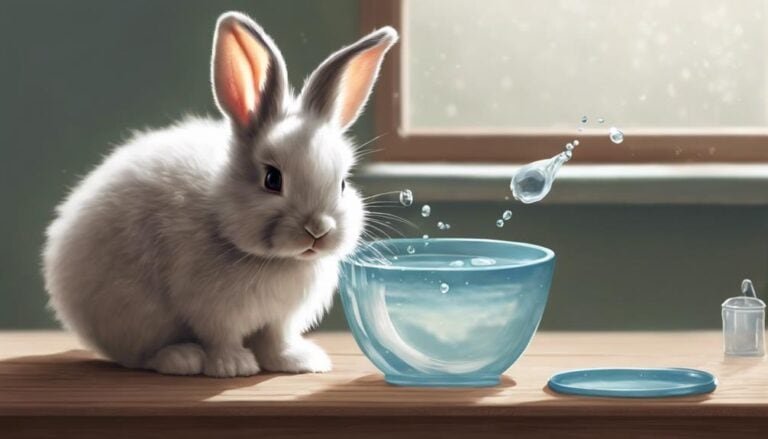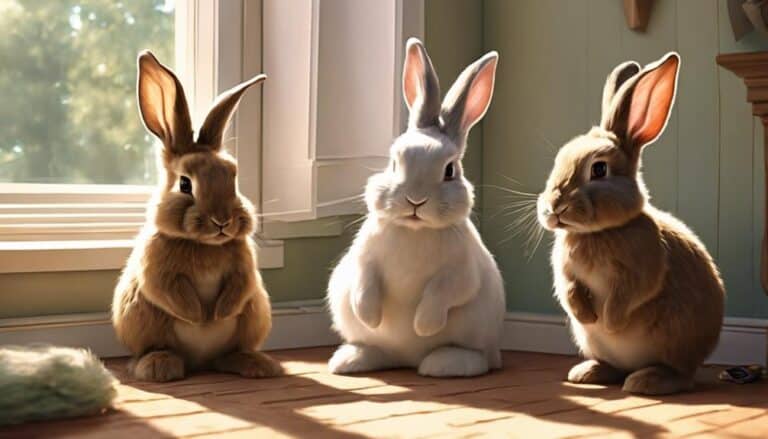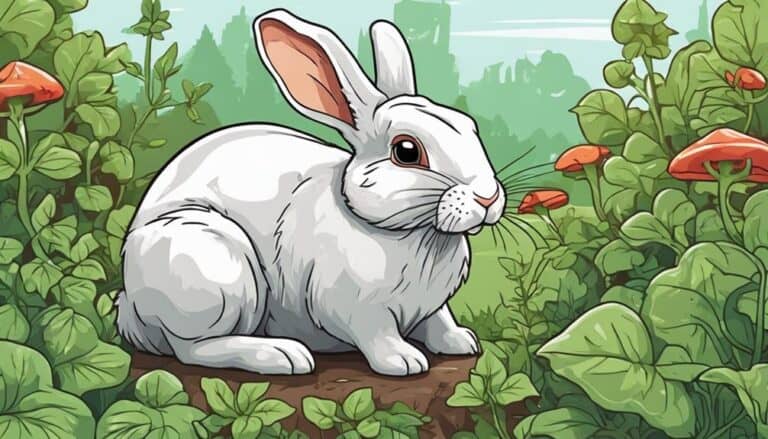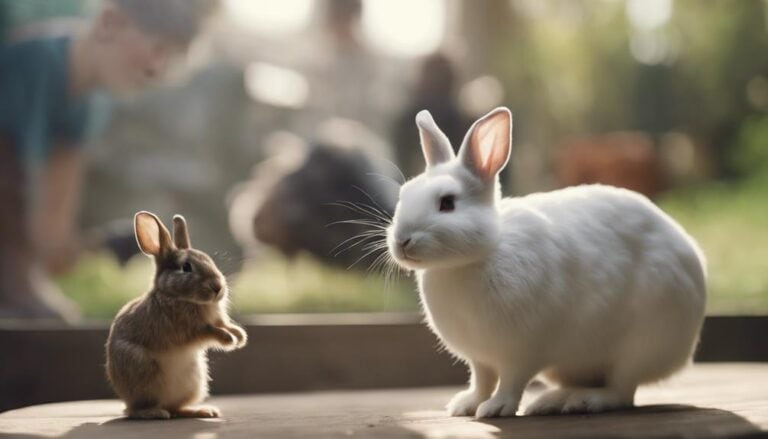So you're wondering how well Mini Lop and Lionhead rabbits get along? It's a great question, especially if you're considering bringing these two breeds together in the same space.
When it comes to bonding, Mini Lops and Lionheads can make great companions. Both breeds are friendly, social, and relatively easy-going, which helps set the stage for a harmonious relationship.
That being said, it's essential to understand their individual personalities and needs to ensure they connect and thrive together.
One key thing to keep in mind is that both Mini Lops and Lionheads are prey animals, so they may have similar instincts and reactions to certain situations. This can actually help them bond, as they'll often understand and respond to each other's behaviors. For example, if one rabbit senses danger, the other may pick up on its cues and react accordingly.
That being said, there are some potential challenges to be aware of. For instance, Mini Lops can be a bit more energetic and playful than Lionheads, which may lead to conflicts if the Lionhead feels overwhelmed. On the other hand, Lionheads can be more territorial and may require more space and resources, which could cause tension with the Mini Lop.
Despite these potential challenges, the good news is that with patience, consistency, and proper training, Mini Lops and Lionheads can develop a strong and lasting bond. By providing a safe, comfortable environment and plenty of opportunities for socialization and play, you can help these adorable rabbits become the best of friends.
Contents
- 1 Key Takeaways
- 2 Bonding Behaviors of Mini Lop Rabbits
- 3 Characteristics Affecting Rabbit Bonds
- 4 Tips for Successful Rabbit Bonding
- 5 Importance of Neutering in Bonding
- 6 Health Considerations for Bonding Rabbits
- 7 Factors Influencing Bonding Success
- 8 Introducing Mini Lops and Lionheads
- 9 Creating a Safe Bonding Environment
- 10 Common Bonding Challenges to Overcome
- 11 Signs of a Strong Rabbit Bond
- 12 Conclusion
Key Takeaways
Mini Lop and Lionhead rabbits are social animals, so it's no surprise that they bond well. Their easy-going personalities make it easy for them to form strong bonds with each other.
When it comes to bonding, mental stimulation is key. Both breeds need to be challenged and engaged to foster a healthy bond. One great way to do this is by training them for tricks. This not only provides mental stimulation but also helps to strengthen their bond with each other.
However, bonding isn't just about mental stimulation. Neutering and proper health care are vital components of successful bonding. By taking care of these basic needs, you can help create a strong foundation for your rabbits' relationship.
Bonding Behaviors of Mini Lop Rabbits
Mini Lop rabbits are super social and friendly, which makes them perfect for forming strong bonds with other rabbits. They're easy-going, so they get along well with rabbits of different breeds, like the Lionhead.
Since they're active and curious, they need plenty of exercise and mental stimulation to prevent boredom and stress. If they don't get enough, it can affect their bonding with both humans and other rabbits.
On the plus side, Mini Lops are smart and can be trained to use a litter box and even do tricks. This helps them form stronger bonds with their caregivers and fellow rabbits.
However, it’s essential to remember that Mini Lop rabbits can be prone to health issues like dental problems and obesity. If these problems aren’t addressed quickly, they can affect their overall well-being and, in turn, impact their bonding behaviors. Regular veterinary check-ups are crucial to catch any early signs of these health concerns. Additionally, some rabbit owners may find that their Mini Lop doesn’t get along well with other breeds, especially if they have specific sensitivities, such as minirex rabbits and allergies. A well-balanced diet and proper exercise can significantly improve their quality of life, ensuring they remain playful and affectionate companions.
Understanding these bonding characteristics is crucial for building successful relationships between Mini Lop rabbits and their companions.
Characteristics Affecting Rabbit Bonds
When it comes to the bond between Mini Lop and Lionhead rabbits, understanding their bonding behaviors is crucial. But what really matters is how individual personality traits impact their relationships.
Each rabbit breed has its own unique characteristics that affect how they form connections with each other and their human companions. For instance, factors like temperament, socialization, and communication styles play a significant role in shaping their bonds.
Think about it – some rabbits are naturally more friendly and outgoing, while others are more reserved and independent. These personality differences can greatly influence how well they get along with each other, and even with their human caregivers.
Bonding Behavior Analysis
When it comes to bonding rabbits, their physical characteristics, like breed, aren't as important as you might think. Instead, it's their individual personalities and temperaments that really matter.
Some rabbits are naturally more dominant, while others are more submissive. These traits can greatly impact how they interact with a potential mate. That's why understanding the importance of hierarchy within rabbit relationships is crucial for a harmonious bonding process.
Age and past experiences also play a significant role in how rabbits form bonds. For instance, younger rabbits might bond more easily than older ones. However, with patience and proper care, it's still possible to achieve successful pairings regardless of age.
Creating a secure and neutral environment is essential for bonding. This helps reduce stress and anxiety in rabbits, allowing them to establish connections in a positive atmosphere. By focusing on the individual characteristics of each bunny and providing appropriate care, you can enhance the bonding experience and create lasting companionships.
Personality Traits Impact
Understanding how personality traits impact rabbit bonding dynamics is key to fostering successful relationships between rabbits.
When it comes to bonding, the personalities of the rabbits involved play a huge role. Female rabbits are known to be more territorial than males, which can impact bonding dynamics.
Aggressiveness can hinder the bonding process because aggressive behavior can lead to conflicts. On the other hand, highly sociable rabbits tend to bond more easily with other rabbits. Dominance also comes into play, as establishing a dominance hierarchy is common during bonding, which can impact the relationship. Shy rabbits may take longer to bond because they need time to build trust. And finally, playful rabbits can engage positively during bonding sessions, making the process smoother.
Considering these personality traits can help rabbit owners understand and navigate the bonding process more effectively, especially when bonding female rabbits. By being aware of these traits, you can create a more harmonious and successful bonding experience for your rabbits.
Tips for Successful Rabbit Bonding
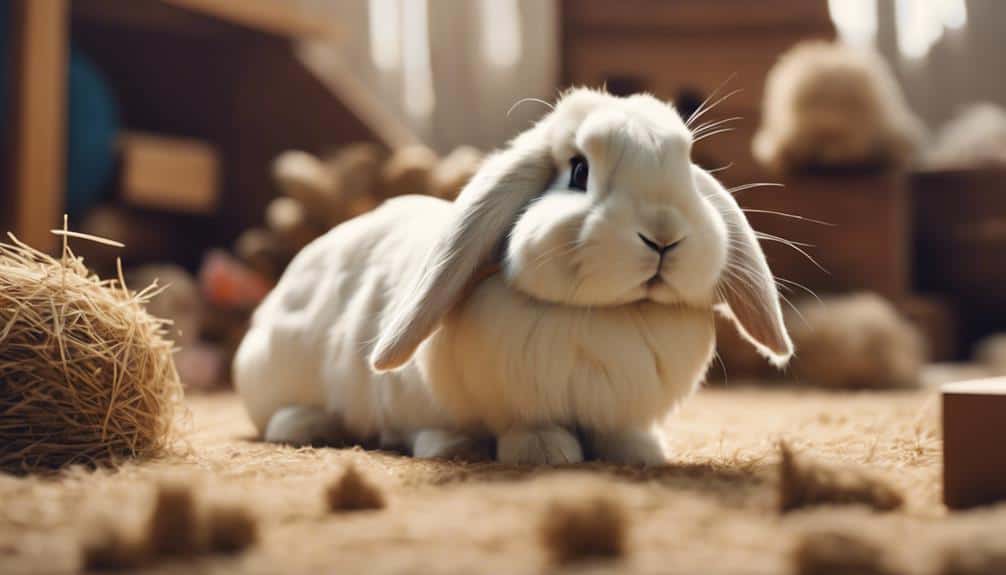
Bonding rabbits requires some planning and patience, but with the right approach, you can help them get along beautifully.
First, it's crucial to spay or neuter your rabbits before introducing them. This helps reduce territorial behavior and aggression, which can be triggered by hormones.
When you're ready to start the bonding process, choose a neutral area where your rabbits can't get cornered. A bathtub is often an ideal spot because it's easy to access and provides good traction.
Begin with short playdates of 5-15 minutes and gradually increase the time as they become more comfortable with each other. Wear gloves initially to protect yourself from any potential nips or scratches. Keep a close eye on their behavior during these sessions, and intervene if you notice any signs of aggression.
As your rabbits become more relaxed around each other, you can gradually increase the size of their play area. Reward them with treats at the end of each session to create positive associations.
When you're ready to move them to a permanent play area, make sure to thoroughly clean all surfaces to prevent territorial issues.
Importance of Neutering in Bonding
Neutering is a crucial step in helping rabbits bond successfully. When rabbits aren't spayed or neutered, their hormones can cause territorial behavior and aggression, making it tough for them to get along.
This is especially important when you're adopting two rabbits at the same time. If they're not fixed, their hormone-driven behavior can create problems in their relationship.
There are some exceptions to this rule, though. For example, if you have two sisters from the same litter, or if you're pairing a senior rabbit with a baby rabbit and the senior is already fixed, you mightn't need to worry about neutering.
However, if you don't spay or neuter your rabbits before trying to bond them, you might end up having to separate them and start the bonding process all over again if their hormone-driven behaviors get in the way.
Health Considerations for Bonding Rabbits
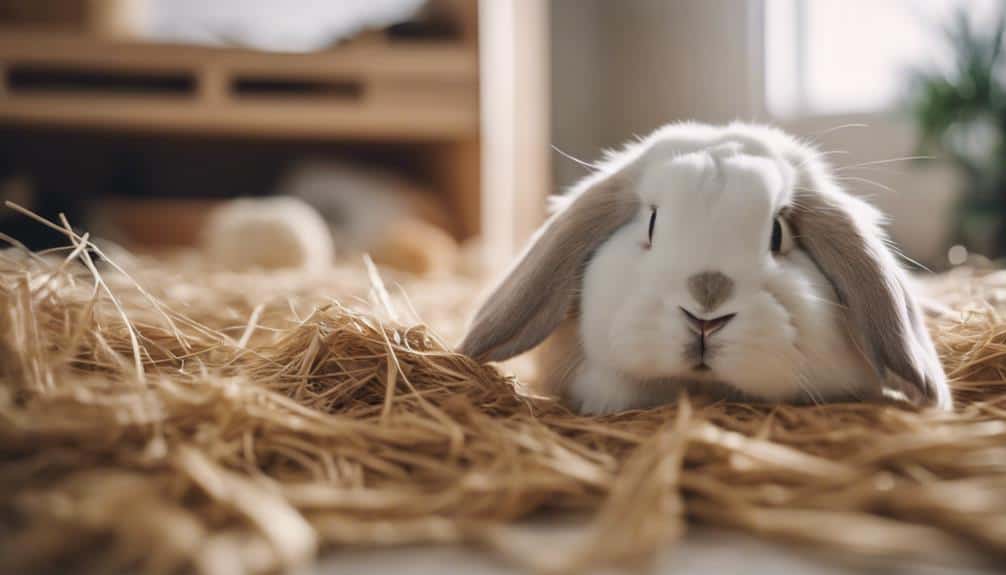
When you're thinking about bonding rabbits, their health has to be your top priority. You need to keep a close eye out for any signs of distress or underlying medical issues that could affect the bonding process. If you notice any serious health problems, like a rabbit not eating or pooping for 12-24 hours, you need to get them to a vet right away.
This might delay the bonding process, but it's crucial for their health.
Spaying or neutering your rabbits is also essential for successful bonding. Hormones can cause territorial behavior and aggression, which can really hinder the bonding process. You should get guidance from a vet on the best time to introduce your rabbits to each other, especially if they've any health issues like dental problems that could affect the process.
While you're bonding your rabbits, it's crucial to keep an eye on their health. Stress and anxiety can lead to health complications if you don't address them quickly.
You should only attempt to bond your rabbits when they're both healthy and free of any underlying medical issues. A healthy foundation is key to a successful and harmonious rabbit bond.
Factors Influencing Bonding Success
So, you're wondering what makes bonding rabbits together a success? When it comes to pairing up two bunnies, several factors can make or break their relationship.
The age and temperament of the rabbits play a huge role. Generally, rabbits around the same age tend to get along better because they've similar energy levels and behaviors. For instance, if you've got a high-energy bunny, it's best to pair it with another high-energy rabbit.
Another crucial factor to consider is the weight and size of the rabbits. For example, trying to bond a 10-pound female with a much smaller rabbit might lead to dominance issues. You want to make sure they're evenly matched to avoid any conflicts.
Providing a neutral space for the rabbits to interact is also vital. This space should be free of any one rabbit's scent to avoid territorial behavior. You don't want one bunny feeling like it's defending its turf from the other.
The introduction process is also key. You want to do it gradually, allowing the rabbits to get used to each other's presence without feeling threatened. This might take some time and patience, but it's worth it in the end.
Introducing Mini Lops and Lionheads
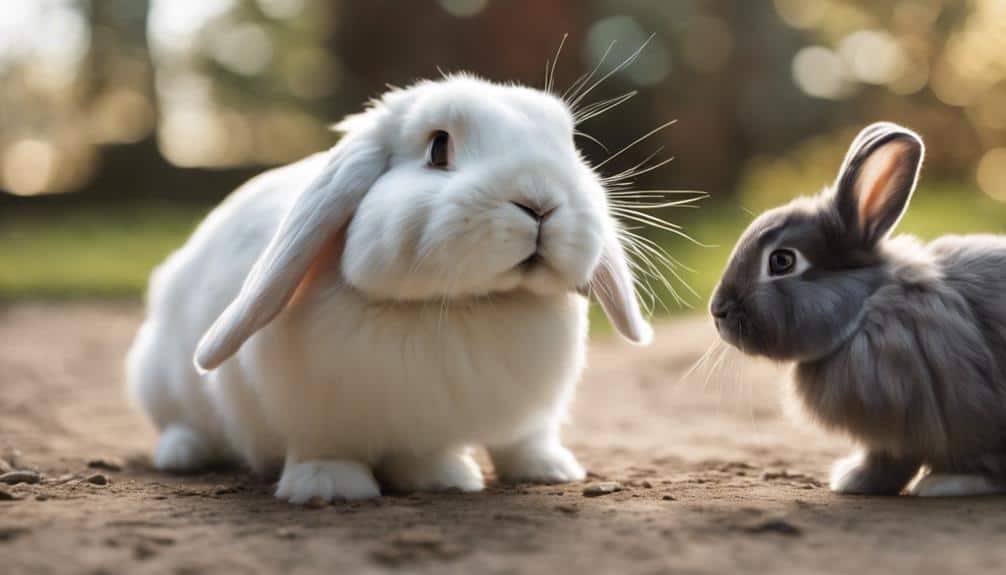
Introducing Mini Lop and Lionhead rabbits requires careful consideration of their individual personalities and the environment where they'll interact. Mini Lops are known for being social and friendly, while Lionheads can be more reserved and cautious.
When introducing them, it's essential to do it slowly in a neutral territory under close supervision. This will prevent any aggressive behavior from arising.
Provide separate living spaces for each rabbit initially, so they've their own safe areas to retreat to if needed.
Use treats and positive reinforcement to encourage good behavior when they're together. This will create a positive association between them.
If you encounter any challenges during the introduction process, don't hesitate to seek advice from a House Rabbit Society or a rabbit behavior specialist. They can provide guidance tailored to your rabbits' specific needs.
Remember to ensure you have a safe environment for the rabbits to interact before proceeding further. This is crucial for a successful introduction.
Creating a Safe Bonding Environment
Creating a safe space for your Mini Lop and Lionhead rabbits is crucial to prevent stress and promote a positive interaction. You want to make sure they feel comfortable and secure around each other.
One way to do this is by introducing them in a neutral area, like a bathtub. This helps prevent territorial behaviors and lets them get to know each other in a calm environment. Wearing gloves can also be a good idea, just in case things don't go as planned.
To set up a safe space, create a small area that your rabbits can't escape from. Keep this space clean and free from any distractions. This will help your rabbits feel more at ease and build trust with each other. By doing this, you'll be setting the stage for a successful bond between your furry friends.
Safe Space Establishment
So you want to create a safe space for your Mini Lop and Lionhead rabbits to bond successfully. To do this, you'll need to provide a secure and calm environment with minimal distractions and ample space for interaction.
Rabbits are super sensitive animals. So, it's really important to keep noise levels low during their bonding sessions. Loud noises can startle them and disrupt the whole bonding process.
Make sure to provide hiding spots for your rabbits. Both Mini Lop and Lionhead rabbits appreciate having a place to retreat to if they feel overwhelmed. Offering hiding spots, such as tunnels or boxes, gives them a sense of security during bonding sessions.
Methodical Introduction Techniques
When bonding Mini Lop and Lionhead rabbits, it's crucial to do it gradually and in a methodical way.
To start, introduce them in a neutral area like a bathtub or a spacious exercise pen. This space provides a safe environment for their initial meeting, reducing the chances of territorial behaviors or aggression.
At first, keep them separated but let them see, smell, and hear each other. This allows them to recognize each other's visual cues and scents.
Over time, increase their interaction time while closely monitoring their behavior and body language for any signs of stress or fear. Make sure to include hiding spots, toys, and treats to reduce stress and create a positive association with the bonding experience.
Always supervise their interactions closely, being ready to intervene if necessary. Even bonded rabbits can have disagreements, and early intervention can prevent potential injuries.
With time and patience, you can foster a strong bond between your Mini Lop and Lionhead rabbits.
Common Bonding Challenges to Overcome
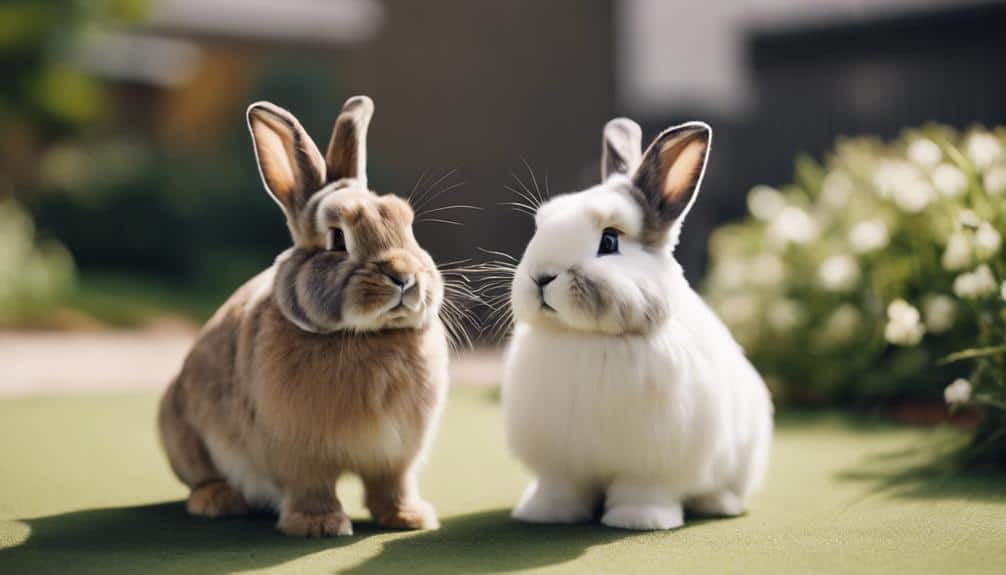
When you're trying to bond Mini Lop and Lionhead rabbits, you might run into some common challenges. These can make the process a bit tricky, but with some careful attention to your rabbits' health and behavior, you can overcome them.
For example, you might notice that your rabbits are exhibiting rivalry behaviors. This can include things like food guarding or humping, which can lead to conflicts and make it harder for them to bond. It's really important to address these behaviors right away so you can help your rabbits develop a harmonious relationship.
Another challenge you might face is territorial tensions. Rabbits are naturally territorial, and when you introduce a new companion, it can trigger those territorial instincts. This can cause stress and even aggression. One way to deal with this is to create a neutral space where your rabbits can meet for the first time. This can help reduce territorial tensions and make the bonding process smoother.
Hormonal fluctuations can also be a significant barrier to bonding. These fluctuations can affect your rabbits' behavior and compatibility. One way to reduce the impact of these fluctuations is to spay or neuter your rabbits before introducing them to each other. This can really increase the chances of a successful bond.
Signs of a Strong Rabbit Bond
As a rabbit owner, you want to know if your Mini Lop and Lionhead rabbits have formed a strong bond.
One way to figure this out is by paying attention to their body language. When they're relaxed around each other, that's a good sign. They might even give each other gentle nudges, which is a clear indication that they feel comfortable with each other.
Another way to tell if your rabbits have a strong bond is by observing their grooming habits. Rabbits often groom each other as a way of showing affection. If you notice your rabbits doing this, it's a good sign that they trust and care for each other.
Trust is a big part of any strong bond, and it's especially important for rabbits. When they trust each other, they feel safe and secure, which leads to a deeper connection.
Body Language Cues
When it comes to understanding the bond between your Mini Lop and Lionhead rabbits, observing their body language cues can be super helpful. By paying attention to these cues, you can get a sense of how strong their connection is and even help promote their well-being.
For starters, take a look at their tail movement and ear positioning. If a rabbit is feeling relaxed, its ears will typically be up and slightly forward. On the other hand, a flicking tail might indicate that they're feeling excited or agitated.
You should also keep an eye out for nudging or circling behavior between the two rabbits. If one rabbit is gently nudging or circling the other, it could be a sign of affection and bonding. This behavior often crops up when rabbits are figuring out their hierarchy within their relationship.
Want to know how strong the bond is between your Mini Lop and Lionhead rabbits? Just observe their shared grooming rituals. When rabbits are close, they often groom each other. This isn't just about keeping their fur clean; it's about strengthening their bond and getting along with each other.
When your Mini Lop and Lionhead rabbits groom each other, they're not just keeping each other's fur in good condition – they're also building trust and companionship. In fact, social grooming is a big part of how rabbits build trust with each other. If you see your rabbits doing this, it's a sign that they've a deep connection.
What's even more interesting is that this behavior can extend beyond their own species. If you have other pets in the house, your rabbits might even groom them. If you see this happening, it shows that your rabbits are really good at forming connections – even with animals that aren't rabbits. This highlights just how important companionship is to them.
Mutual Trust Building
Mutual trust building is a beautiful thing to see between Mini Lop and Lionhead rabbits. Their consistent grooming rituals are a great example of this, showing just how strong their bond is based on companionship and trust. These activities not only make them feel secure, but they also bring the rabbits closer together emotionally, resulting in a harmonious relationship.
To take this trust to the next level and make their bond even stronger, it's essential to engage in specific trust exercises and bonding activities with your rabbits.
For instance, trust-building exercises like hand-feeding treats or gentle handling can help establish a foundation of trust between your Mini Lop and Lionhead rabbits. Bonding activities, such as supervised playtime in a neutral space or introducing new toys, can promote positive interactions and strengthen their bond.
Effective communication strategies also play a key role in enhancing trust and understanding within your rabbit pair. By observing their body language cues and responding appropriately to their needs, you can take their relationship to a whole new level.
To solidify this bond, it's crucial that you explore these strategies.
Conclusion
So, you want to know if Mini Lop and Lionhead rabbits can get along?
The answer is yes, they can form strong bonds if you introduce them slowly, build trust, and do bonding activities regularly. The key is to be patient and understand their unique personalities.
To make it work, you need to create a safe and comfortable space for them.
You'll also need to overcome some common challenges that can come up when bonding rabbits.
But if you do it right, you'll be rewarded with a heartwarming connection between these adorable rabbits.

